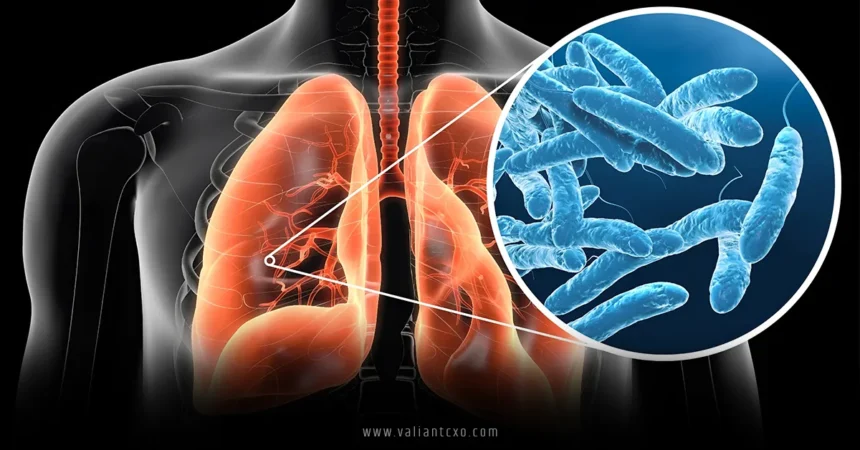Legionnaires disease is a sneaky, potentially deadly form of pneumonia that catches many people off guard. Imagine a quiet intruder lurking in the water systems we rely on daily—your shower, your office’s air conditioning, or even that decorative fountain in the mall. It’s caused by Legionella bacteria, which thrive in warm, stagnant water and can turn a routine breath into a serious health crisis. In this article, we’ll dive deep into what Legionnaires disease is, how it spreads, who’s at risk, and how you can protect yourself. Let’s unravel this hidden danger together!
What Is Legionnaires Disease?
Legionnaires disease is a severe type of pneumonia caused by inhaling tiny water droplets contaminated with Legionella bacteria. First identified in 1976 during an outbreak at an American Legion convention in Philadelphia (hence the name), this illness isn’t your average cold. It can hit hard, with symptoms like high fever, chills, cough, and muscle aches that can escalate quickly if untreated. Unlike a virus that spreads from person to person, Legionnaires disease comes from environmental sources, making it a unique and preventable threat.
Think of Legionella as a stealthy villain, hiding in places we don’t often suspect. It loves warm water—think 77°F to 113°F (25°C to 45°C)—and thrives in neglected plumbing systems, cooling towers, or hot tubs. When these systems release mist or vapor, the bacteria can hitch a ride into your lungs. Scary, right? But understanding this is the first step to staying safe.
How Does Legionnaires Disease Differ from Other Pneumonias?
You might wonder, why single out Legionnaires disease when pneumonia has so many causes? Unlike viral or bacterial pneumonia spread through coughing or sneezing, Legionnaires disease doesn’t pass between people. It’s tied to specific environments, which makes it both trickier to catch and easier to prevent with the right measures. Also, its symptoms can mimic other illnesses, which often leads to delayed diagnosis. That’s why knowing its unique traits—like its link to water systems—is crucial.
How Does Legionnaires Disease Spread?
Picture this: you’re enjoying a relaxing spa day, soaking in a hot tub. Unbeknownst to you, the water hasn’t been properly treated, and Legionella bacteria are having their own party. When the jets kick on, tiny droplets float into the air, carrying the bacteria straight to your lungs. This is the primary way Legionnaires disease spreads—through inhaling contaminated water droplets.
Common Sources of Legionnaires Disease
The bacteria behind Legionnaires disease love man-made water systems. Here are the usual suspects:
- Cooling towers: These are often part of large air-conditioning systems in hotels, hospitals, or office buildings. If not maintained, they’re Legionella breeding grounds.
- Hot tubs and spas: Warm, bubbly water is a paradise for these bacteria if chlorine levels aren’t kept in check.
- Plumbing systems: Old or poorly maintained pipes in homes or buildings can harbor Legionella.
- Decorative fountains: That serene fountain in a lobby? It could be a silent source of infection if not cleaned regularly.
- Misters and humidifiers: Devices that create fine water droplets can spread the bacteria if the water source is contaminated.
Natural water sources like rivers or lakes can also host Legionella, but outbreaks are rare unless the water is used in man-made systems. The key is stagnation—when water sits still, bacteria multiply like uninvited guests at a picnic.
Can You Catch Legionnaires Disease from Someone Else?
Nope! Legionnaires disease isn’t contagious. You won’t catch it from a sick coworker or a family member. It’s all about the environment, which makes prevention a matter of controlling water systems rather than avoiding people.
Who Is at Risk for Legionnaires Disease?
Not everyone exposed to Legionella gets sick, but certain groups are more vulnerable. Think of your immune system as a fortress—when it’s strong, it can fend off invaders like Legionella. But if the walls are weakened, the bacteria can storm in. Here’s who’s most at risk:
- Older adults: People over 50, especially those over 65, have a harder time fighting off infections.
- Smokers: Smoking damages your lungs, making them an easier target for Legionella.
- People with chronic illnesses: Conditions like diabetes, COPD, or kidney disease weaken your defenses.
- Immunocompromised individuals: Those with HIV, cancer, or on immunosuppressive drugs are at higher risk.
- Travelers: Staying in hotels or cruise ships with poorly maintained water systems can increase exposure.
If you’re young and healthy, your risk is lower, but don’t get too comfortable—anyone can get sick under the right (or wrong) conditions.
Symptoms of Legionnaires Disease
So, what does Legionnaires disease feel like? It’s not subtle. Symptoms typically show up 2 to 14 days after exposure and can include:
- High fever (often above 104°F or 40°C)
- Chills that make you shiver like you’re stuck in a snowstorm
- A dry or productive cough
- Muscle aches that feel like you ran a marathon
- Shortness of breath
- Headaches and fatigue
- Sometimes gastrointestinal issues like nausea or diarrhea
These symptoms can escalate fast, especially in high-risk groups. If you’re feeling like you’ve been hit by a truck and have been around a suspect water source, don’t wait—see a doctor ASAP.
Pontiac Fever: The Milder Cousin
There’s a less severe illness caused by Legionella called Pontiac fever. It’s like Legionnaires disease’s little sibling—flu-like symptoms without the pneumonia. It usually resolves on its own, but it’s still a sign that Legionella is lurking.
Diagnosing Legionnaires Disease
Diagnosing Legionnaires disease can be tricky because it looks like other types of pneumonia. Doctors typically rely on:
- Urine tests: These detect Legionella antigens (proteins) in your body.
- Sputum cultures: A sample of mucus from your lungs can confirm the bacteria.
- Chest X-rays: These show signs of pneumonia but can’t pinpoint Legionella alone.
- Blood tests: These check for signs of infection or immune response.
If you’ve been in a high-risk setting—like a hotel with a recent outbreak—make sure to tell your doctor. Context is everything!
Treatment for Legionnaires Disease
Good news: Legionnaires disease is treatable with antibiotics, but timing is critical. Doctors often prescribe drugs like azithromycin or levofloxacin to knock out the infection. If caught early, most people recover fully, but severe cases may require hospitalization, especially if breathing becomes difficult.
Why Early Treatment Matters
Delaying treatment is like letting a small fire grow into a blaze. The sooner antibiotics start, the better your chances of a quick recovery. For high-risk groups, untreated Legionnaires disease can lead to complications like respiratory failure or kidney damage.
Preventing Legionnaires Disease
Prevention is where we can really take control. Since Legionnaires disease comes from water systems, keeping those systems clean is your best defense. Here’s how:
- Maintain hot tubs and pools: Regular cleaning and proper chlorine levels keep Legionella at bay.
- Flush plumbing systems: If a building has been vacant, run the water to clear stagnant pipes.
- Clean cooling towers: Regular maintenance and water treatment are non-negotiable for large buildings.
- Use clean water in humidifiers: Always use fresh, treated water in devices that create mist.
- Monitor water temperatures: Keep hot water above 140°F (60°C) and cold water below 68°F (20°C) to discourage bacterial growth.
For individuals, avoiding smoking and staying healthy can strengthen your immune system, making you less susceptible.
What Can Building Managers Do?
If you manage a hotel, hospital, or office building, you’re on the front lines. Regular inspections, water testing, and maintenance plans are your weapons against Legionnaires disease. The CDC’s toolkit for controlling Legionella is a great resource for creating a water management plan.
Legionnaires Disease Outbreaks: A Growing Concern
Outbreaks of Legionnaires disease are on the rise, often linked to large buildings or public spaces. In recent years, cases have spiked in the U.S. and Europe, with hundreds of people affected annually. Why? Aging infrastructure, lax maintenance, and warmer climates create perfect conditions for Legionella. A single outbreak can sicken dozens, as seen in high-profile cases in hotels, cruise ships, and even hospitals.
Notable Outbreaks
Remember the 1976 Philadelphia outbreak? That was the wake-up call. Since then, we’ve seen outbreaks in places like New York City’s Bronx in 2015, where over 100 people fell ill, and in Flint, Michigan, during the water crisis. These events highlight the need for vigilance in water system maintenance.
Living with Legionnaires Disease: Recovery and Beyond
Recovering from Legionnaires disease can be a slog, especially for severe cases. You might feel wiped out for weeks, even after antibiotics. Rest, hydration, and follow-up care are key. For some, lung damage or fatigue can linger, so listen to your body and don’t rush recovery.
Emotional Impact
Getting hit with a serious illness like Legionnaires disease can shake you up. It’s normal to feel anxious about water systems or future infections. Talking to a healthcare provider or counselor can help you process the experience.
Legionnaires Disease and Public Health
Public health officials are stepping up to combat Legionnaires disease. Agencies like the World Health Organization provide guidelines for water safety, while local health departments investigate outbreaks. But it’s a team effort—building owners, facility managers, and even you play a role in prevention.
What Can You Do?
Stay informed! If you hear about an outbreak in your area, check your water systems and avoid high-risk settings like poorly maintained hot tubs. Knowledge is power when it comes to Legionnaires disease.
Conclusion
Legionnaires disease is a hidden threat, but it’s one we can tackle with awareness and action. From understanding its causes and symptoms to taking steps to prevent it, we’ve got the tools to keep this bacterial villain at bay. Whether you’re a homeowner flushing your pipes or a facility manager overseeing a cooling tower, every action counts. Stay vigilant, stay informed, and let’s keep our water systems safe. After all, nobody wants to be sidelined by a disease that’s preventable with a little care. Ready to take charge of your health and safety? Start by checking the water systems around you today!
Frequently Asked Questions (FAQs)
1. What is Legionnaires disease, and how do you catch it?
Legionnaires disease is a severe form of pneumonia caused by Legionella bacteria. You catch it by inhaling tiny water droplets from contaminated sources like hot tubs, cooling towers, or plumbing systems. It’s not contagious between people.
2. Who is most at risk for Legionnaires disease?
Older adults (over 50), smokers, and people with chronic illnesses or weakened immune systems are most vulnerable to Legionnaires disease. Healthy individuals can get it too, but the risk is lower.
3. How is Legionnaires disease treated?
Legionnaires disease is treated with antibiotics like azithromycin or levofloxacin. Early treatment is crucial to prevent complications, and severe cases may require hospitalization.
4. Can I prevent Legionnaires disease at home?
Yes! Regularly clean and disinfect hot tubs, flush stagnant plumbing, and use fresh water in humidifiers. Keeping water systems well-maintained reduces the risk of Legionnaires disease.
5. Where can I learn more about Legionnaires disease prevention?
Check out resources from trusted sources like the Environmental Protection Agency for tips on water safety and preventing Legionnaires disease.
For More Updates !! : valiantcxo.com


